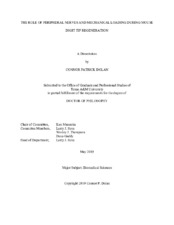| dc.description.abstract | In the past two decades, several groups have shown that the mammalian digit tip
regeneration is peripheral nerve-dependent. However, there is a serious gap in this body of
literature as no one has characterized the neuroanatomy of the digit. Addressing this important
gap in knowledge, my dissertation used several approaches to directly test the hypothesis that
peripheral nerves contribute to digit regeneration. Specifically, my specific aims were to 1)
characterize the neuroanatomy of the unamputated and regenerated mouse digit, 2) directly test
the dependence of peripheral nerves on digit tip regeneration, and 3) to determine whether digit
tip regeneration is dependent upon mechanical load.
In Chapter 2, I show that the neuroanatomy of the unamputated mouse digit is organized
in a region-specific manner which are distinct in axon and Schwann cell composition. Curiously,
I also demonstrate that after digit tip regeneration, nerve and Schwann cell regeneration is
impaired. These results suggest that the mouse digit tip regeneration may not be as nerve-dependent
as was previously proposed.
In Chapter 3, I re-explore the paradigm that mammalian digit tip regeneration is
peripheral nerve-dependent. In reviewing the literature that demonstrates peripheral nerve-dependency,
it is apparent that all of the earlier work had utilized sciatic denervation to study
regeneration in a nerve-free environment. While this is a robust procedure for removing nerves
downstream of the injury, it is also a well-established model of decreasing mechanical loading
of the denervated limb. I hypothesized that decreased mechanical loading following sciatic
denervation could be confounding the previous work that demonstrates digit tip regeneration is
peripheral nerve-dependent.
To test the role of mechanical loading during regeneration without damaging peripheral
nerves, a model known as hindlimb unloading was utilized. These studies revealed that when
mice were hindlimb unloaded, they were unable to mount a regeneration response after injury. I
next set out to test the role of peripheral nerves during digit regeneration without decreasing
mechanical loading. To do this, I developed a novel surgical procedure in which denervation was
performed at the level of the digit. Digit denervation maintains the animals ability to ambulate,
thus minimizing any deficits in mechanical loading. Startlingly, the studies demonstrate that after
digit denervation surgery, amputated digits are able to mount a robust regeneration response.
Taken together, these results strongly indicate that mouse digit tip regeneration is a
peripheral nerve-independent phenomena, and that previous reports indicating that digit tip
regeneration is peripheral nerve-dependent are confounded by the fact that sciatic denervation
decreases mechanical loading. | en |


